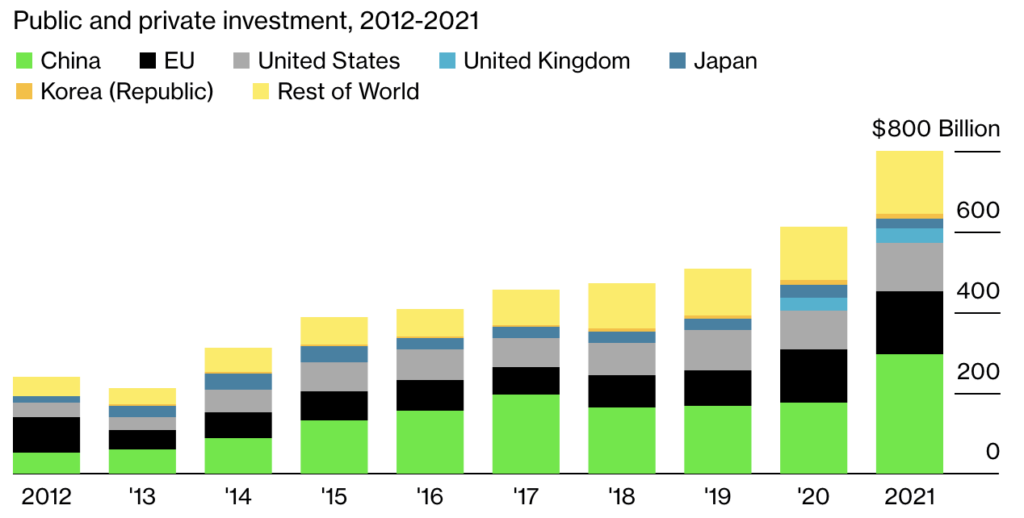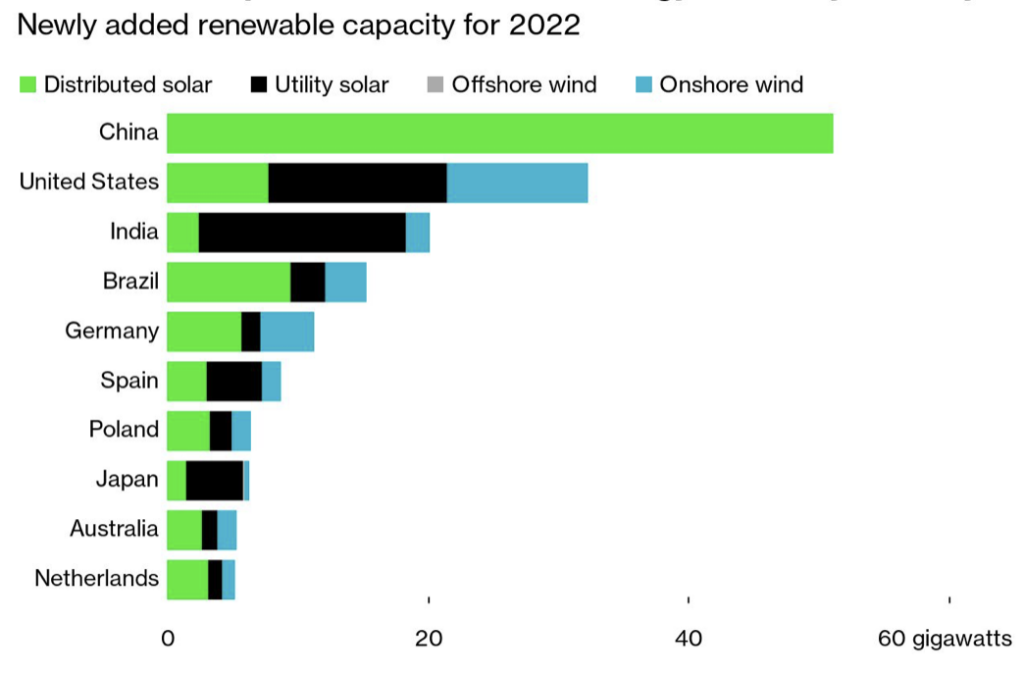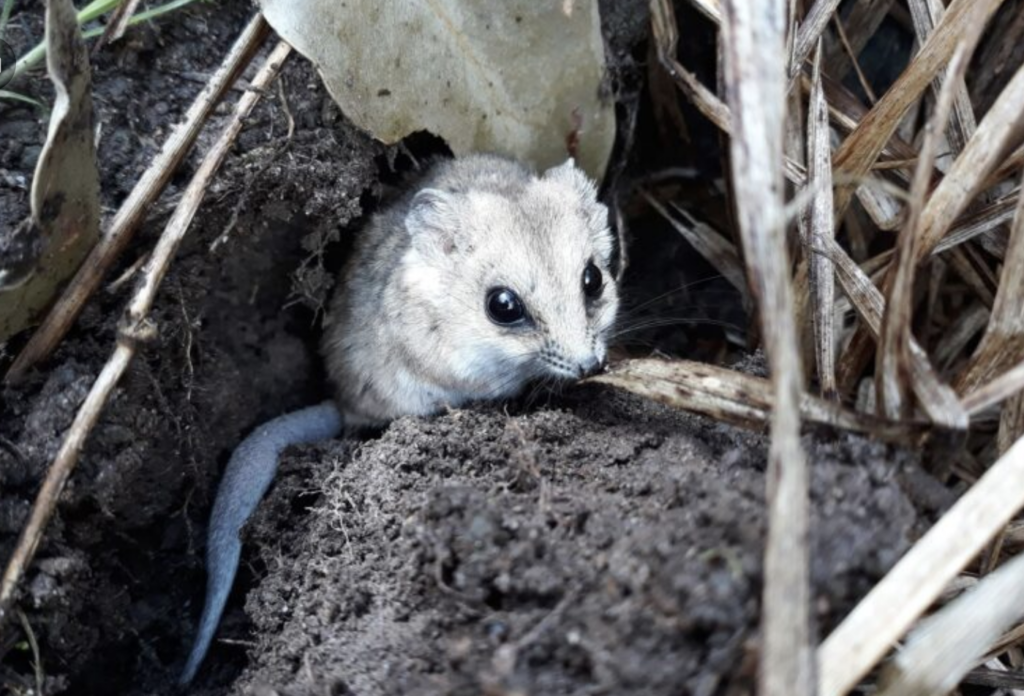Environment: Energy transition’s progress is AC. Needs to be DC
April 9, 2023
China leads the world in building both coal and renewable infrastructure. Ten leading drivers of climate action are ineffective at keeping warming below 2oC. More and more species exposed to extinction as temperatures rise.
The many faces of China
The USA might spend as much on its military as the next ten countries put together but China is even more dominant in steel production, producing twice as much as the next nine countries combined.

China is also leading the way with new coal power plants. In 2022, China ramped up both project approvals and the construction of new-coal fired power plants. Over 100GW of new coal power was approved (that’s about two large plants per week), more than six times the rest of the world combined. This represents a massive increase in approvals after a few quiet years for China since 2015.

Project approvals and construction of new coal power (GW) in China and the rest of the world in 2022
There’s a conundrum though. These massive additions of coal-fired capacity don’t necessarily mean that coal use or CO2 emissions from the power sector will increase in China. If growth in China’s non-fossil power generation continues to accelerate and the growth in its electricity demand stabilises, power generation from coal could soon peak and decline. Xi’s promise to peak China’s coal consumption towards the end of this decade might then be met.
China is certainly building up its renewable energy supplies. It is, for instance, by far the world’s biggest investor in the energy transition. In 2021, China accounted for over 35% of global green energy investment, about the same as the EU and USA combined. And in 2022 it was leading the field in adding renewable capacity, mainly with distributed (or roof top) solar which now constitutes 40% of China’s solar energy generation (the two graphs below are from Bloomberg Green Daily on 13 and 28 March 2023).


China is also leading the way, or controlling the market depending on how you wish to see it, with the processing of the minerals required for the energy transition and with the production of batteries – more about that another week.
Building 2050’s grid
Making the energy transition happen depends upon the distribution of electricity, not just its production. Crisply put, ‘ There is no transition without transmission’.
But to become net-zero by 2050 the world will need to install about 80 million kilometres of power lines. I think that’s 2,000 times around the Earth and roughly equal to what we currently have. The new lines are predicted to cost over US$17 trillion, but there’s also the US$4 trillion required to maintain the current grid. About 85% of the new power lines will be above ground. The annual demand for copper will increase from 5 to 23 million tons.
Premature electrification
Not everyone seems convinced about the benefits of electrifying everything, though. Apparently some males are too worried about running out of power before they reach their destination to purchase an EV. I suspect that such men won’t be very amused by this ad, and as a result it’s unlikely to convince them to change their mind. The ending is particularly cruel.
It’s a genuine ad with a mocking tone, by the way. Such is my ignorance of all things automotive that I had to Google ‘Ram REV’ to discover that it is indeed a real vehicle and that the ad isn’t just a spoof.
Warmer world will increase species extinction
Compared with 1850-1900, the current global average 1.1oC of warming (about 0.9oC over the ocean and 1.6oC over the land) is associated with a rate of species extinction that is already 100-1000 times higher than the long term historical norm. More worryingly, the four maps below graphically demonstrate that what we are currently experiencing is just the tip of the iceberg (a supremely inappropriate metaphor).

(The graphic is originally from the IPPCC’s Sixth Assessment Report on Impacts, Adaptation and Vulnerability published last year but it is reproduced in a slightly different format in the IPCC synthesis report I discussed two weeks ago, Figure SPM.3.)
The increase in the percentage of species of animals, corals and sea grasses exposed to potentially dangerous conditions is very noticeable as warming increases from 1.5oC to 2oC but the increased exposure if global warming reaches 3oC and then an inconceivable 4oC will be truly catastrophic. Tropical land and sea areas, which are currently the most abundant in species, will be particularly hard hit. If only a fifth of the 80-100% of exposed species in these areas become extinct, that’s still around 20% of all the species there. But note that there will also be high losses in mid-latitudes across the Americas, Africa, Asia and Europe, mountainous areas such as the Rockies, Andes and Himalayas, and even the Arctic.
Not to alarm you but we are currently on track for warming of somewhere around 2.5-3.0oC this century. And this is without considering the highly likely transgression of climate tipping points that will accelerate global warming or the removal from the atmosphere of aerosols which are released by the burning of fossil fuels and are currently having a cooling effect of about 0.5oC.
Talking of icebergs and metaphors, Thomas Hardy penned a chilling poem, The Convergence of the Twain, about the Titanic nine days after it sank in 1912. A century on, the Titanic could be a metaphor for economic growth (and humanity’s hubris) and the iceberg for climate change (and the laws of physics).
Ten social drivers of climate action
The objectives of the University of Hamburg’s Climate, Climate Change, and Society (CLICCS) Cluster of Excellence include:
- Develop assessments of which climate futures are possible and which are plausible;
- Identify the social prerequisites for the deep decarbonisation required to reach the Paris climate targets.
The 2023 Climate Futures Outlook report by CLICCS provides an assessment of how influential ten social drivers of change and six environmental processes are likely to be in achieving the deep decarbonisation needed across the world by 2050 to keep global warming under the Paris Agreement’s 2oC limit by 2100.
The overall results are depressingly predictable:
- Meeting the Paris Agreement’s aspirational 1.5oC goal is no longer plausible, full stop!;
- None of the ten social drivers currently support achievement of the deep decarbonisation required by 2050 to stay under 2oC but warming could still be kept under two degrees if ambition and implementation were ramped up.
I’ll leave that there.
What really interested me about this report, however, were the ten social processes the researchers selected and analysed to provide measures of the extent to which human agency can affect global warming over the next three decades. In a nutshell:
-
Seven of the social drivers do support decarbonisation but not at the level required to achieve deep decarbonisation:
- The UNFCCC climate change framework
- Transnational decarbonisation agreements and initiatives
- Within-nation regulation related to climate change
- Climate protests and social movements
- Litigation that supports decarbonisation
- Divestment from fossil fuels
- Climate-related knowledge and resources for the public.
-
Two drivers actively undermine pathways to any decarbonisation, never mind deep decarbonisation:
- Corporate sector responses to climate change
- Global consumption patterns.
-
And one has an each way bet, sometimes supporting and sometimes undermining decarbonisation:
- Media attention to and framing of climate change.
None of this is helped by the ongoing covid epidemic or the consequences of the war in Ukraine.
Just for the record, the six physical processes examined were:
- Arctic sea-ice decline
- Polar ice-sheet melt
- Regional variations in climate change causing an unlikely but high impact event such as a local or regional tipping point
- Thawing of the northern hemisphere’s permafrost
- Changes to the Atlantic Meridional Overturning Circulation (the north-south circulating currents in the Atlantic Ocean)
- Amazon forest dieback.
Results indicated that the first three will have little influence on global mean temperature leading up to 2050 and hence little influence on achievement of the Paris Agreement. The last three may push up global warming moderately and may make staying under 2oC even less likely.
It’s the social drivers that we need to concentrate on, however, if we want to decarbonise the world and slow global warming. We would do well to take a leaf out of the Johnny Mercer songbook.
Save Australia’s dunnies
It isn’t quite the world’s smallest mammal but at only 15gm the Fat-tailed dunnart is getting pretty close. Unfortunately, habitat loss and feral animals on the grasslands of the Volcanic Plains west of Melbourne are driving it to extinction. The Victorian government’s Scientific Advisory Committee has recommended that the dunnart, a predator related to Tasmanian Devils and quolls, be listed as vulnerable in the state.


